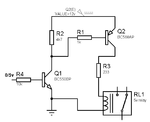snaku
Junior Member level 3

Hi everyone,
I have to drive a relay(which needs 5V and 30 mA) using a PNP transistor. I am giving 12 V to the transistor. I want 5v with 30 mA as output at the collector. How do I achieve this??? Please help me.
I have to drive a relay(which needs 5V and 30 mA) using a PNP transistor. I am giving 12 V to the transistor. I want 5v with 30 mA as output at the collector. How do I achieve this??? Please help me.


